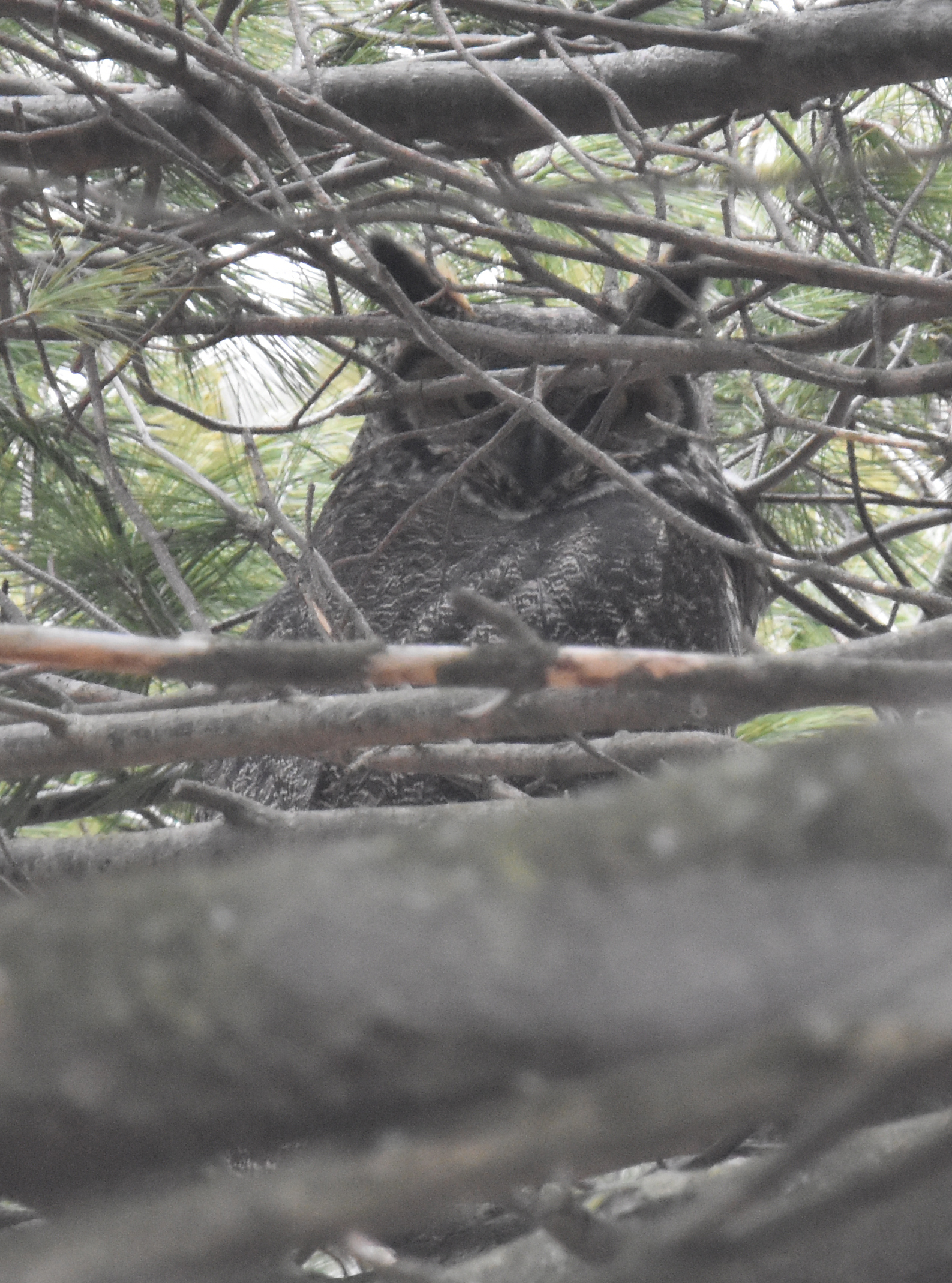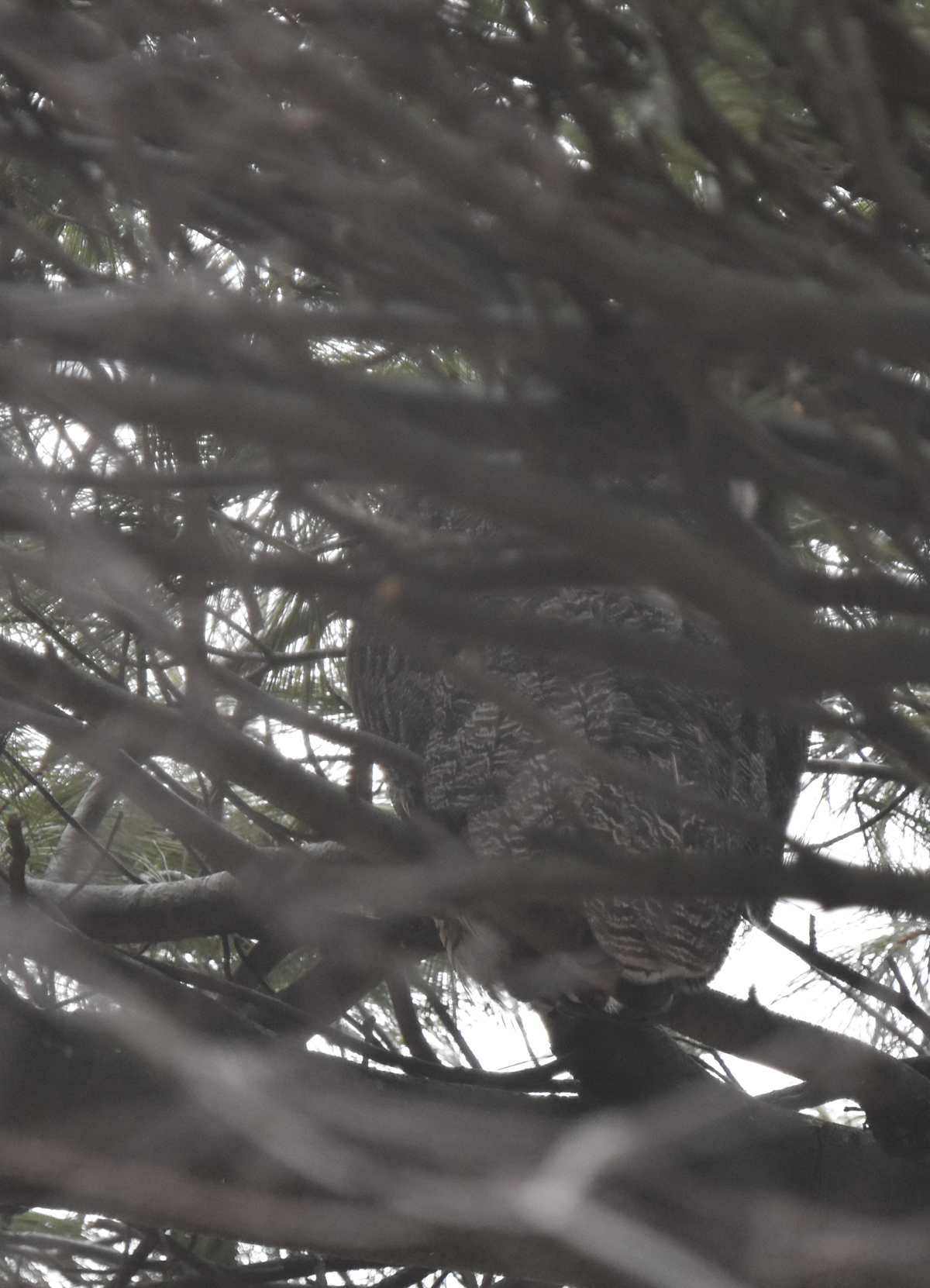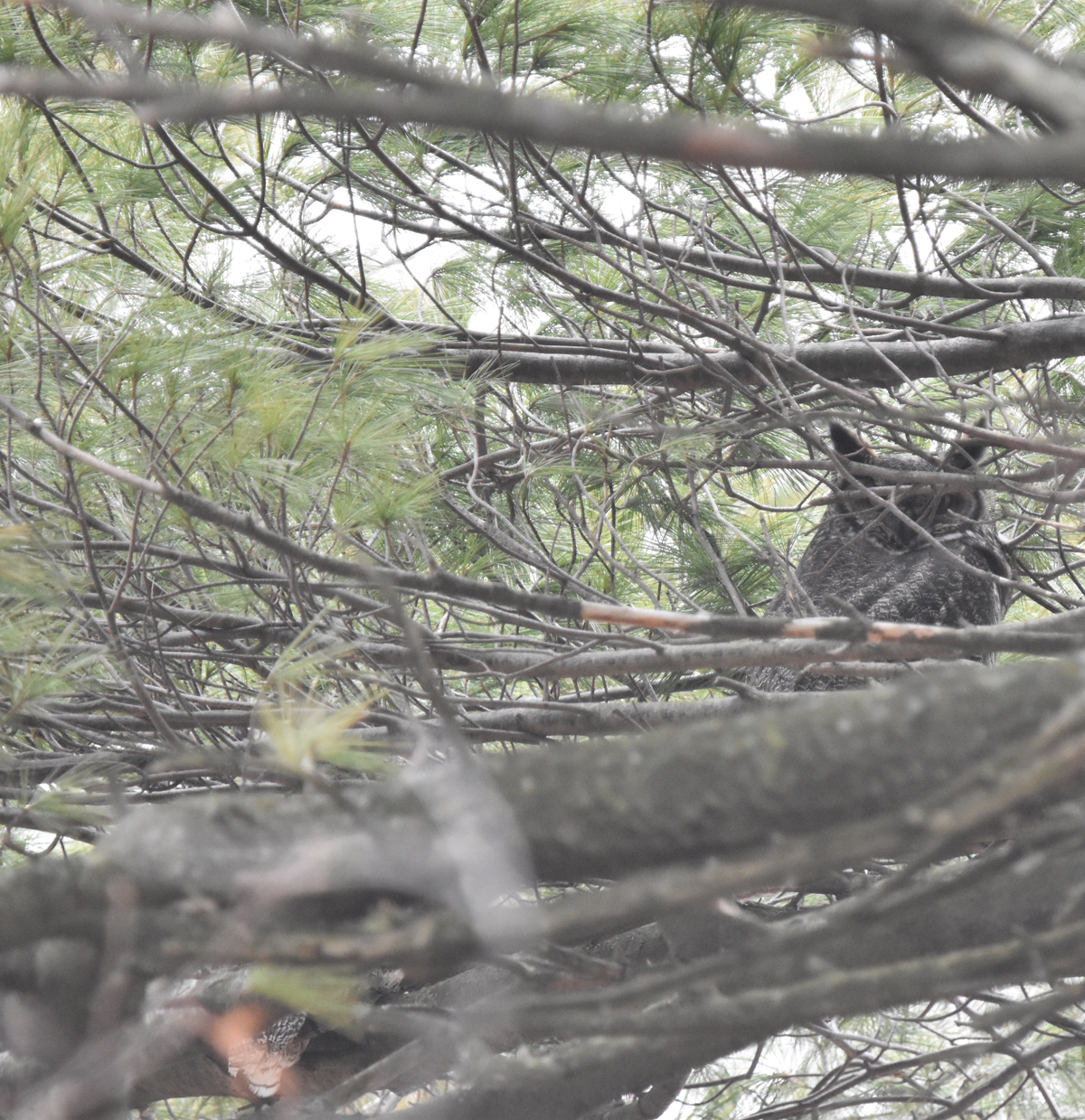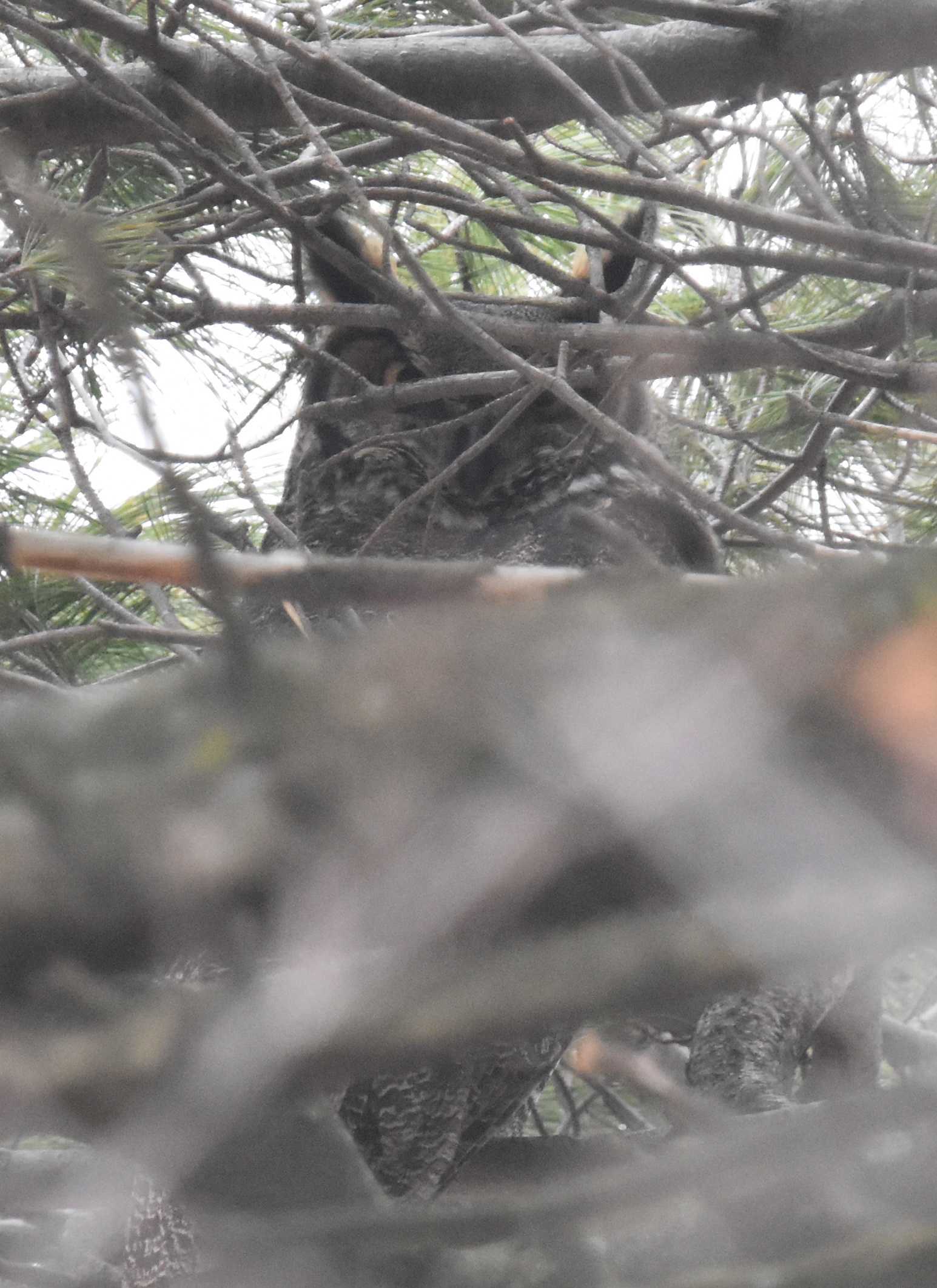On a recent walk through the woods, not in Mississauga or Oakville, I heard some Black-capped Chickadees scolding loudly. It surprised me a bit as most of the local Chickadees were down near another path hoping for handouts from the dog-walkers and Sunday strollers. Ever hopeful of an interesting find, I walked briskly to where the birds were calling and looked up, way up.
Where Should I Look for Great Horned Owls in February and Why?
I didn’t know what was in the White Pine tree that the Chickadees were pestering. They would flit up onto bare branches near the greenery, call ‘chick a dee dee dee dee dee’ then zip down again. At least 5 birds were flying to and from the pine though none was going too close to the greenery.
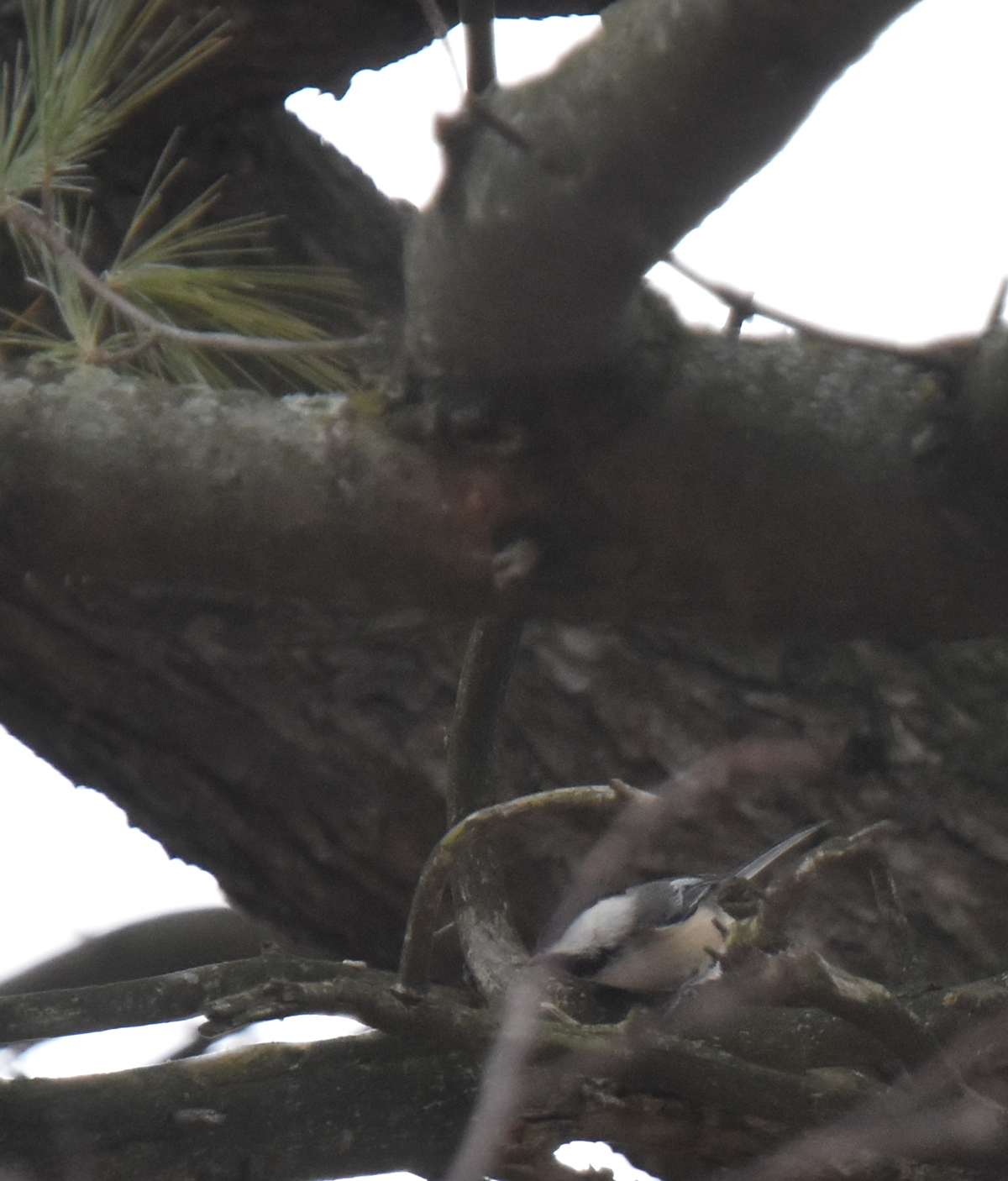
One of the Outraged Warning ‘Larm alert system, OWL alert, Chickadees
I started looking at the densest part of the back-lit green-needled branches. It was a dim afternoon so the lighting was not helping me. I also did not have binoculars with me and the tree was 30 metres away from the trail and the branches were another 20 metres or so up the trunk. My camera has a 600 mm lens but that just meant I could tell it was a pine tree!
The first thing I noticed was a dark vertical mass on one branch. I quickly took a few pictures then tried to look at them on the little display screen of my camera. Zoomed in, the mass looked like a large paper wasp nest.
So, however, do some owls. Both Barred and Great Horned Owls are about the size and colour of a big wasp nest. And Chickadees would not be worried about a wasp nest in February!
Moving to another angle, I kept scanning the branches through my lens, taking photos on the “just in case and digital ‘film’ is free” basis.
Then either I changed angles or the bird moved because suddenly I was looking at a curved dark shape with unmistakable ear tufts! I had found a Great Horned Owl by listening to what the Chickadees were shouting.
Once I had the bird located, I realized that the Chickadees were brave and upset but not stupid. They never went within 3 metres of the owl, preferring to keep up their pestering from a safe distance.
In February, Great Horned Owls in southern Ontario are often starting to nest. I was curious whether this owl might be one of a breeding pair, so I took a lot of photos hoping to see later at home whether there was any sign of a nest nearby. Having seen a Great Horned Owl that nested in a cave in a limestone cliff in Kananaskis in Alberta, in a dead tree in BC, and in an old hawk nest in Ontario, I knew I might not recognize the nest site even if I was looking at it but it was worth a try.

A dense clump of branches like this is worth looking at: in fact there are two owls in here!
It’s pretty common for Great Horned Owls to try to hide in the daytime from pesky Chickadees and Crows, so I try looking for them in conifers especially near large clumps of dense branches or near the trunk.
Are Owls Easy to See?
Even large owls like Great Horned’s can be hard to see. I tried to point out the owl’s head, ear tufts and all, to another couple passing by. Even with my amazing directions (“It’s in the pine tree, right where the branches get tangled together; It looks like a black football with horns; Right up there; way, way up.”) they were not able to see the bird. At least, eventually, they were looking at the correct tree.
(Why don’t they put letters on every trunk in the forest, and numbers on every branch? Imagine the ease of birding when you could call the birds like Bingo: There’s an owl in G43 just near the tip…..)
Anyway, when I was home looking at my photos in detail, I wondered whether the “wasp nest” owl I had first seen had moved and become the “head with tufts” owl or whether there were two birds in the tree. So I scrutinized each photo slowly are carefully.
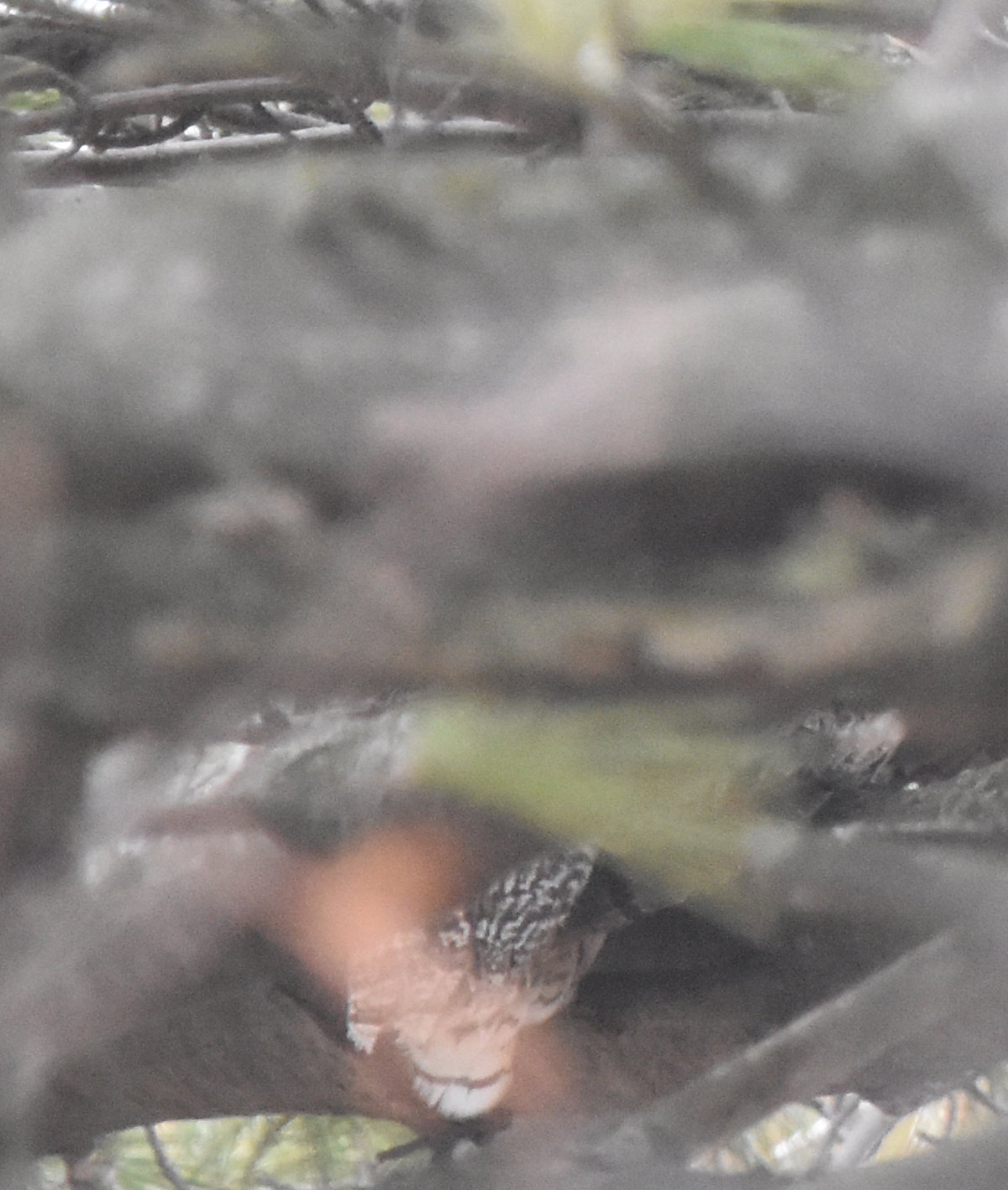
Yes, there is another tail in there!
Sure enough, I found another set of tail feathers a good metre away from the head. So there were actually two Great Horned Owls in the tree that day!
Rule #2: Don’t Pester the Owls Yourself!
It was hard for this poor owl to rest while it was being pestered by the Chickadees. (I didn’t include any here, but many of my photos show the back of the bird’s head as it kept turning to keep an eye on them.) I didn’t want to add to its misery by alarming it. So I stayed on the path (a good Lyme-disease-prevention strategy anyway) many, many, many metres away. And I didn’t stop long on the trail.
It’s easy to forget that even though I’m very happy to see an owl it probably is less thrilled to see me. Luckily this time I remembered and moved away before the owl felt it had to leave to escape me.
Do Great Horned Owls Migrate in Ontario?
These owls taught me something new: Great Horned Owls, like Snowy Owls, do not migrate but they can move south in winter.
When I first was reviewing my Owl photos at home on the computer, I was checking to make sure they really were Great Horned Owls. My every instinct said they were but I knew Screech Owls nest in that park so I checked my photos carefully. I also examined lots of photos of Long-eared Owls, just in case. Of course the size alone made it unlikely these were anything but Great Horned’s, but I checked.
One thing that puzzled me is that the descriptions of Great Horned Owls mentioned a cinnamon facial disk around the eyes and bill. My photos, taken under poor lighting conditions, really didn’t. I finally noticed a bit of rusty colouring in one photo (only).
Satisfied, I cropped it out to show here.
Then, today while looking for more info on nesting in southern Ontario, I discovered an interesting article by Jean Iron and another by Ron Pittaway. In the articles, they discuss the fact that some Great Horned Owls from northern Ontario tend to be more grey and white and lack most or all of the rufous colouring. They also taught me that some years, Great Horned Owls will move south in search of food, just like Snowy Owls.
Now I’m left wondering—did I see the year-round resident pair of Great Horned Owls at this southern Ontario park, or did I get a fleeting glimpse of a pair heading swiftly back north now that spring is almost here? (I suspect they were the resident local owls.)
Either way, I was very pleased to share a few minutes on a late afternoon ramble in February with two such striking birds—even if they were camera and Chickadee shy!
Related Reading
- What Big Owl is Being Chased By Crows and Hawks in Mississauga?
- What Hand-sized Owl is Watching Me from that Hole in the Tree Trunk?
- A Snowy Owl at Bronte Harbour
- Snowy Owl Springs Up in LaSalle Park
- Subspecies of Great Horned Owl in Ontario by Ron Pittaway
Join In
Do Great Horned Owls nest near your home? Please share your sighting with a comment.

